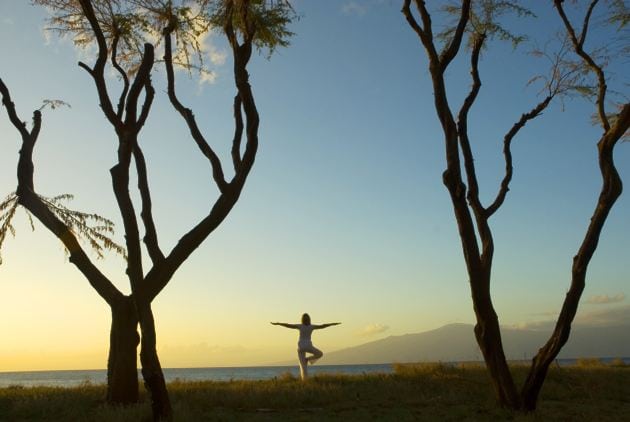A new year is upon us, and some of you’ve decided to start a yoga practice. That’s why you’re checking out DOYOU, yes? But when you sat down at your computer to find your first class, the schedule featured words like Vinyasa, Ashtanga, Hatha, or Iyengar. Vin-what you might think? And if that isn’t puzzling enough, these names probably had numbers or levels as well. Level 1, 2/3 or beginner or intermediate/advanced… what exactly do these mean? It can all just be enough to get you to rethink your fitness choice. But it might help to know we’ve all been there before. You don’t have to give up.
You could just plunge in, but. . .
Confession: when I started practicing yoga, I didn’t really pay attention to levels or classes or even teachers, oh, my! Time dictated my choices most often: evening classes after work mostly. Now, years later, I wouldn’t recommend my method to a beginning yogi; I was lucky enough to have had relatively few physical issues to work with, and I also had a good sense of body awareness from growing up playing sports. I also would station myself in the back or middle of the class where I could more easily follow the group if I got lost. Though some classes were over my head, I was a fast learner and I also knew enough to be patient if I couldn’t get the poses right away. There were some methods to my madness.
When the first impression is less than stellar. . .
I do wish I’d a little more focus in those early exploratory days, but, thankfully, I didn’t have a bad experience to turn me away. However, not every student has as positive an introduction to yoga as I did. It can take a while to find your groove when starting a new regimen, and yoga is no different, particularly when there are so many yoga styles and so many teachers with their unique spin. I’ve witnessed looks on some newbies’ faces when they walk into a vigorous Vinyasa class and they were really looking for a restorative, gentle class, or the students who were looking for a fast-moving practice and land in a slow, alignment-oriented class. It can be frustrating to say the least, and scary or somewhat dangerous at its worst. And if you get a “bad” introduction to yoga, it’s that much harder to get back onto your mat to try another class.
Let your fingers do some preliminary work.
Before you walk into your first yoga class, it can help to do a little research. If you’re considering yoga as part of your New Year’s health kick, take these three steps to help you ensure your intro to yoga is a fun one rather than scary or frustrating.
1. Choose your style
No one yoga is exactly alike. There are yoga styles that range from vigorous and acrobatic to gentle or therapeutic. Figure out what you’re looking for in a class (i.e. a workout, relaxation, meditation). And keep your current health in mind (i.e. if you have any health issues or injuries to consider). Most studio websites will have class descriptions to give you an idea of what to expect and help you avoid a rude awakening when you get there. And there are also plenty of resources that offer helpful breakdowns of yoga styles, including this one!
2. Be conservative about your level at the start
Every yogi had to start somewhere, and taking a level one or beginner/basic class is not a sign of defeat. Unlike what some might think, the level is not necessarily equivalent to your athletic ability or strength. It more precisely indicates the level of experience in yoga. Think about it: How can you expect to take a more advanced class if you don’t know the names of basic poses when the teacher calls them out? A level 1 or beginner class is often the time where you can more easily learn basic poses as well as get an introduction to foundational movements. Beginner classes typically lay the groundwork so everyone is on the same page. Then when you feel confident enough after several classes, you can always move on to a higher level class without as much fear of getting lost or overwhelmed.
3. Don’t stop with just one class
Just like with potato chips, you’ll need more than one experience to get a real taste of yoga. If you can, make some time to try out different classes, teachers or even studios. It will help in giving you a better sense of the vast offerings of yoga, as well as allow you to better choose what works best for you and your body.
These steps can still be helpful whether you’re a new yogi and a veteran. Even after years of practice, I still like to do a little research before I walk into any class in a new place.
And remember, Do You!
One of the elements of yoga that I appreciate is its reminder about our own abilities and accountability. The practice teaches us that we have more wisdom and power than we realize, and we can learn to exercise that power whether it’s in the middle of yoga practice when we choose to rest in Child’s pose while the class moves into lunges or if it’s taking time to research classes to better choose the right one for our needs. We can be active participants in our choices, and that will go a long way to building a more sustainable life practice.
Here’s to rockin’ those New Year’s intentions with a little can-do!


